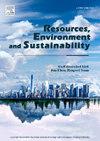提高秸秆与氮肥联合施肥对土壤质量和籽棉产量的影响,实现棉花可持续种植
IF 12.4
Q1 ENVIRONMENTAL SCIENCES
引用次数: 0
摘要
秸秆还田配氮肥优化是实现棉花可持续生产的重要途径。然而,秸秆还田与氮肥联合施肥对土壤质量和籽棉产量的定量分析仍不确定。基于7年的大田试验,研究了秸秆还田和施氮量(分别为75、150和300 kg N ha−1,分别为N75、N150和N300)对华东棉麦种植体系土壤质量指数(JFE- sqi)和籽棉产量(JFE- y)的动态特征。结果表明,中等施氮量(即n150)秸秆还田可通过降低容重、增加土壤固碳和固氮、促进养分有效性、刺激微生物生长和提高土壤酶活性等方式改善土壤质量,从而提高棉籽产量及其稳定性。秸秆还田N150也能协同提高JFE-SQI和JFE-Y。同时,N150时JFE- sqi和JFE- y具有协同效应(JFE >;前5年为10%),第6年为累加效应(- 10%≤JFE≤10%)。当JFE-SQI适中时,JFE-Y最高,说明JFE-SQI和JFE-Y之间存在氮驱动的权衡。此外,气候因子对籽棉产量和JFE-Y均有显著影响。综上所述,合理的秸秆还田和氮肥管理策略是在全球气候变化下实现棉花可持续种植的有效途径。本文章由计算机程序翻译,如有差异,请以英文原文为准。

Enhancement joint fertilization efficacy of straw and nitrogen fertilizer on soil quality and seedcotton yield for sustainable cotton farming
Straw return with optimizing nitrogen fertilizer is an important way to achieve sustainable cotton farming. However, quantitative analysis of joint fertilization efficacy (JFE) of straw return and nitrogen fertilizer on soil quality and seedcotton yield remains uncertain. Herein, based on a 7-year field experiment, we evaluated the dynamic characteristics of JFE of straw return and nitrogen rates (75, 150 and 300 kg N ha−1, denote as N75, N150 and N300, respectively) on soil quality index (JFE-SQI) and seedcotton yield (JFE-Y) in a cotton–wheat cropping system of East China. The results showed that straw return with moderate nitrogen rate (i.e.N150) improved soil quality by reducing bulk density, increasing soil carbon and nitrogen sequestration, promoting nutrient availability, stimulating microbial growth and enhancing soil enzyme activities, thereby improving seedcotton yield and its stability. Straw return with N150 could also achieve higher JFE-SQI and JFE-Y synergistically. Meanwhile, JFE-SQI and JFE-Y at N150 had a synergistic effect (JFE > 10%) in the first 5 year while a summing effect (−10% JFE 10%) from the sixth year. And the highest JFE-Y could be reached when moderate JFE-SQI was achieved, indicating that there was a nitrogen-driven tradeoff between JFE-SQI and JFE-Y. Moreover, Climatic factor exerted a significant contribution to seedcotton yield and JFE-Y. In conclusion, reasonable straw return and nitrogen fertilizer management strategy is an effective way to realize sustainable cotton planting under the global climate change.
求助全文
通过发布文献求助,成功后即可免费获取论文全文。
去求助
来源期刊

Resources Environment and Sustainability
Environmental Science-Environmental Science (miscellaneous)
CiteScore
15.10
自引率
0.00%
发文量
41
审稿时长
33 days
 求助内容:
求助内容: 应助结果提醒方式:
应助结果提醒方式:


